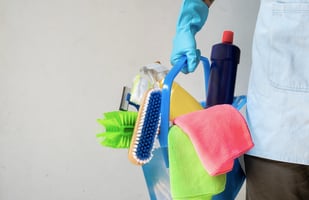 Many essential employees are working hard to keep grocery stores, delivery services, and takeout food services available to the public. With concerns over COVID-19, businesses are enhancing their cleaning procedures. Unfortunately, West Bend has seen an almost 300% increase in workers’ compensation claims associated with chemical exposures in the last 30 days. With increased practices of cleaning “high-touch” surfaces in and around the workplace, it’s essential to protect workers by ensuring proper use and self-protection practices when dealing with cleaning chemicals during this unprecedented time.
Many essential employees are working hard to keep grocery stores, delivery services, and takeout food services available to the public. With concerns over COVID-19, businesses are enhancing their cleaning procedures. Unfortunately, West Bend has seen an almost 300% increase in workers’ compensation claims associated with chemical exposures in the last 30 days. With increased practices of cleaning “high-touch” surfaces in and around the workplace, it’s essential to protect workers by ensuring proper use and self-protection practices when dealing with cleaning chemicals during this unprecedented time.
Many cleaning products, even those bought at the store or considered “consumer-strength” can be harmful. The Environmental Protection Agency (EPA) defines cleaners, sanitizers, and disinfectants as follows:
- Cleaners - remove dirt through wiping, scrubbing, or mopping.
- Sanitizers - contain chemicals that reduce, but don’t necessarily eliminate, microorganisms such as bacteria, viruses, and molds from surfaces. Public health codes may require cleaning with the use of sanitizers in certain areas like toilets and food preparation areas.
- Disinfectants - contain chemicals that destroy or inactivate microorganisms that cause infections. Disinfectants are critical for infection control in hospitals and other healthcare settings.
The Occupational Safety and Health Administration (OSHA) and the Centers for Disease Control and Prevention (CDC) recommend selecting the least potent cleaner required for the job. The more potent the cleaning chemical, the more hazardous it typically is. Limit exposure to harsh chemicals as much as possible.
Disinfectants are generally the strongest, followed by sanitizers, and then standard cleaners.
To ensure the safety of employees, reduce exposure by:
- Following proper storage, handling, and use, including dilution practices, of all cleaning chemicals.
- Knowing what cleaning chemicals employees are working with and how or where to obtain and use hazard information (e.g. product label(s), Safety Data Sheet (SDS), and the Poison Control Number 800-222-1222).
- Not allowing employees to use a product if they haven’t been trained or aren’t knowledgeable in using.
- Making sure the area being cleaned is well ventilated. If necessary, use a fan or open a window. If the smell of cleaning chemicals irritates employees and/or makes them feel light-headed, remove them from the environment.
- Not mixing cleaning chemicals unless instructed to do so. Some chemicals, like a mix of bleach and ammonia, can be toxic and cause serious damage to the skin, eyes, and lungs.
- Not washing skin with cleaning chemicals. This could result in skin irritation or chemical burns.
- Providing the appropriate personal protective equipment to employees:
- Gloves – when handling wet, dry, or aerosol-based chemicals
- Long sleeves – when chemicals may splash or encounter the arms
- Eye protection – when using chemicals that can splash up
- Smock - when chemicals could splash towards the torso
- Directing employees to always wash their hands after handling cleaning chemicals.
- Instructing employees to avoid eating, drinking, or touching their faces, skin, and eyes when working with chemicals.
1 The Environmental Protection Agency (EPA) Design for the Environment (DfE), 2012





